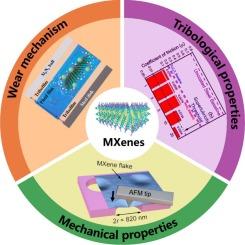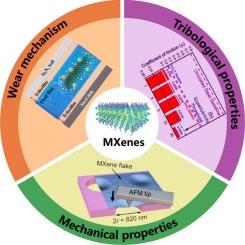二维MXenes的最新进展:合成、机械和摩擦学性能
IF 23.5
1区 化学
Q1 CHEMISTRY, INORGANIC & NUCLEAR
引用次数: 0
摘要
二维过渡金属碳化物、氮化物和碳氮化物,统称为MXenes,由于其独特的层状结构、优异的导电性和可调的表面化学性质,在电磁屏蔽、传感器技术和能量存储等各个领域引起了人们的极大关注。虽然最近的一些综述已经涵盖了MXenes的力学和摩擦学性能,但其结构特性,力学性能和摩擦学行为之间的关系需要进一步系统的探索。本文综述了MXene的合成方法,阐明了MXene的力学性能,并探讨了其摩擦学行为的机理。通过理论计算与实验研究相结合,阐明了MXenes的纳米力学特性,并阐明了其低抗剪强度导致的超润滑行为。此外,我们还探讨了它们在润滑剂添加剂、固体润滑剂涂层和复合材料增强相方面的应用。为了解决MXenes在基础油中的分散挑战,我们提出了创新的策略,包括共价功能化和开发杂化材料,这可以显著提高界面相容性和耐磨性。此外,本文综述了MXenes在摩擦学纳米发电机、生物摩擦学和纳米摩擦学等领域的最新应用进展,重点介绍了其作为柔性可穿戴设备自供电传感器和人工关节润滑剂的潜力。最后,我们提出了在快速发展的摩擦学领域中与MXenes持续发展相关的一些挑战和未来展望。本文章由计算机程序翻译,如有差异,请以英文原文为准。


Recent advances in state-of-the-art 2D MXenes: Synthesis, mechanical and tribological properties
Two-dimensional transition metal carbides, nitrides, and carbonitrides, collectively known as MXenes, have attracted significant attention in various fields, such as electromagnetic shielding, sensor technology, and energy storage, owing to their unique layered structure, excellent electrical conductivity, and tunable surface chemistry. Although several recent reviews have covered the mechanical and tribological properties of MXenes, the relationship among their structural characteristics, mechanical performance, and tribological behavior requires further systematic exploration. This review aims to comprehensively summarize the methodologies for MXene synthesis, elucidate their mechanical properties, and explore the mechanisms underlying their tribological behaviors. By integrating theoretical calculations with experimental investigations, we elucidate the nanomechanical characteristics of MXenes and clarify the superlubricious behavior resulting from their low shear strength. Moreover, we explore their applications as lubricant additives, solid lubricant coatings, and reinforcing phases in composites. To address the dispersion challenges of MXenes in base oils, we propose innovative strategies, including covalent functionalization and the development of hybrid materials, which can significantly improve interfacial compatibility and wear resistance. Additionally, this review deliberates on the latest progress in the applications of MXenes in triboelectric nanogenerators, biotribology, and nanotribology, highlighting their potential as self-powered sensors for flexible wearable devices and as lubricating agents for artificial joints. Finally, we propose some challenges and future perspectives relevant to the continuous development of MXenes in the rapidly growing field of tribology.
求助全文
通过发布文献求助,成功后即可免费获取论文全文。
去求助
来源期刊

Coordination Chemistry Reviews
化学-无机化学与核化学
CiteScore
34.30
自引率
5.30%
发文量
457
审稿时长
54 days
期刊介绍:
Coordination Chemistry Reviews offers rapid publication of review articles on current and significant topics in coordination chemistry, encompassing organometallic, supramolecular, theoretical, and bioinorganic chemistry. It also covers catalysis, materials chemistry, and metal-organic frameworks from a coordination chemistry perspective. Reviews summarize recent developments or discuss specific techniques, welcoming contributions from both established and emerging researchers.
The journal releases special issues on timely subjects, including those featuring contributions from specific regions or conferences. Occasional full-length book articles are also featured. Additionally, special volumes cover annual reviews of main group chemistry, transition metal group chemistry, and organometallic chemistry. These comprehensive reviews are vital resources for those engaged in coordination chemistry, further establishing Coordination Chemistry Reviews as a hub for insightful surveys in inorganic and physical inorganic chemistry.
 求助内容:
求助内容: 应助结果提醒方式:
应助结果提醒方式:


